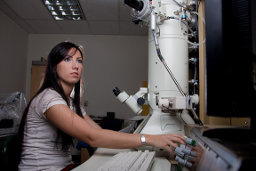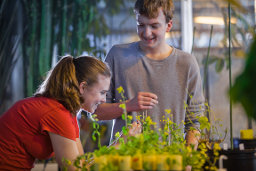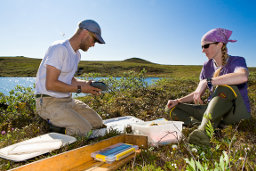Biology and Wildlife Facilities
The Advanced Instrumentation Laboratory (AIL) is a multi-instrument resource for the state of Alaska. It specializes in surface
and elemental analysis as well as electron microscopy. It supports and trains undergraduate
and graduate students and provides technical support and facilities to researchers
as well as local, state, federal, and private agencies.
The Genomics Core Laboratory (DNA Core Lab) maintains an array of equipment for genomics, proteomics, and analytical chemistry.
Services include library preparation and sequencing on Illumina’s MiSeq platform.
Several of our undergraduate and graduate laboratory courses engage students in research
projects, which take advantage of the instrumentation available in the Core Lab.
The Institute of Arctic Biology Greenhouse provides facilities for research and teaching in areas of plant genetics, physiology,
ecology, evolution, and systematics.
The Molecular Imaging Facility provides magnetic resonance imaging services for the UA system. The facility has
two NMR spectrometers for determining small peptide structure, identifying metabolites,
and analyzing environmental samples. The facility also has 1.5 Telsa MRI that can
be used for both imaging and spectroscopy, and recently added a Dual-energy X-Ray
Absorptiometry instrument designed to look at lean body mass, adipose tissue, and
bone density.
The UA Museum of the North houses more than 2.5 million artifacts and specimens, organized into 10 research
disciplines, including archaeology, earth sciences (including paleontology and geology),
entomology, ethnology, documentary film, fine arts, herbarium, ichthyology, mammalogy,
and ornithology. The faculty curators and collections not only provide resources for
academic training at undergraduate, graduate, and postdoctoral levels, but are also
involved in community outreach, including school visits, public presentations, and
workshops.
The Robert G. White Large Animal Research Station (LARS) provides a unique facility for research and education on ungulates from the Subarctic
and Arctic. Faculty and students are engaged in research on the biology, ecology,
physiology, and behavior of muskoxen, caribou, and reindeer.
Toolik Field Station (TFS)is a world-renowned research station located in the northern foothills of the Brooks
Range in Alaska. Toolik-based researchers and students have access to three major
physiographic provinces of Alaska: the Brooks Range, the arctic foothills, and the
Arctic Coastal Plain. Students participating in the Summer Field Course in Arctic
Science, taught at UAF and TFS, learn about the biology of the arctic and boreal forest
systems, including fire ecology, snow ecology, plant ecology, organismal biology,
carbon budgets, and the implications of a warming climate.





